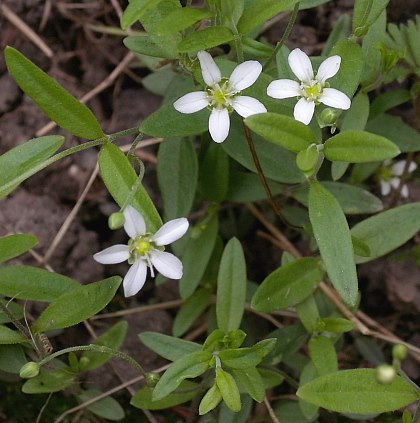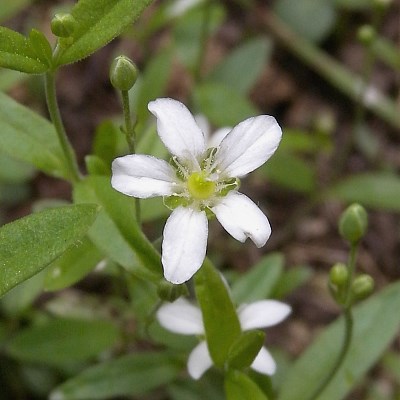
Cultivation: The preference is partial sun to light shade, moist to dry-mesic conditions, and soil that is loamy, gravelly, or sandy with decaying organic matter.
Range & Habitat: The native Grove Sandwort is uncommon in the northern half of Illinois, while in the southern half of the state it is absent (see Distribution Map). Illinois lies along the southern range limit of this species, which has a circumboreal distribution that includes North America, Europe, and Asia. Habitats consist primarily of open woodlands, sandy oak woodlands, woodland borders, and gravelly or rocky borders of streams in wooded areas. Less often, this wildflower occurs in meadows and prairies as an understory plant.
Faunal Associations: The nectar and pollen of the flowers probably attract small bees (Halictid, Andrenid) and flies (Syrphid). Otherwise, little is known about floral-faunal relationships for this species.

Photographic Location: The wildflower garden of the webmaster in Urbana, Illinois.
Comments: This is a delicate and attractive small wildflower that can be easily overlooked. Across local populations of plants, there is some variability in hairiness of the foliage and width of the leaves. Grove Sandwort can be distinguished from similar species in the Pink family by the shape of its leaves, the characteristics of its flowers, and the number of teeth of its seed capsules. Unlike chickweeds (both Stellaria spp. & Cerastium spp.), Grove Sandwort has petals that are neither notched at their tips nor deeply bifurcated. Its flowers are similar to those of Minuartia spp. (Sandworts), but it has wider leaves than the latter and its seed capsules have 6 teeth, instead of 3. Grove Sandwort is also similar to Arenaria serpyllifolia (Thyme-Leaved Sandwort), but its leaves are more long and narrow in shape. Grove Sandwort differs from all of these species by the food appendages (elaisomes) that are attached to its seeds. This is a highly unusual characteristic for a species in the Pink family. A scientific synonym of Grove Sandwort is Arenaria lateriflora.